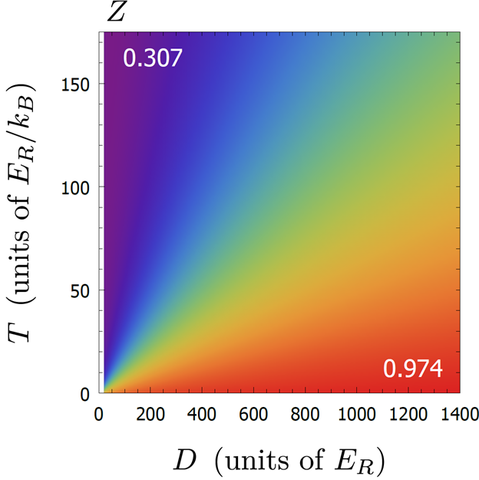Summary
Theory to support the development of high performance optical clocks.
Description

BO+WKB model describing the hyperpolarizability shift in an optical lattice clock with respect to atomic temperature and lattice depth.
An atomic clock aims to realize the intrinsic ticking rate of an atom. This ticking rate (i.e., frequency) is associated with a transition between two quantum levels of the atom, where each level corresponds to a different configuration of the electrons around the nucleus. Atomic clocks derive their incredible accuracy and precision from the robust nature of atoms. Namely, the atomic transition frequency is largely insensitive to external influences. Various mechanisms can nevertheless perturb the frequency, potentially limiting the clock's accuracy and precision. For instance, ytterbium atoms residing in a room-temperature apparatus tick slow by a factor 0.9999999999999976 due to thermal radiation bathing the atoms.
Identifying and mitigating problematic frequency perturbations in atomic clocks often requires evaluating atomic properties, developing theoretical models, or devising novel operational strategies. Our efforts encompass clocks that are both established (e.g., the Yb optical lattice clock) as well as prospective (e.g., the thorium-229 "nuclear" clock).
Relevant Publications
K. Beloy, Trap-Induced ac Zeeman Shift of the Thorium-229 Nuclear Clock Frequency, Phys. Rev. Lett. 130, 103201 (2023)
S. O. Allehabi et al., High-accuracy optical clocks based on group-16-like highly charged ions, Phys. Rev. A 106, 043101 (2022)
K. Beloy, Prospects of a Pb$^{2+}$ Ion Clock, Phys. Rev. Lett. 127, 013201 (2021)
K. Beloy et al., Quadruply Ionized Barium as a Candidate for a High-Accuracy Optical Clock, Phys. Rev. Lett. 125, 173002 (2020)
K. Beloy et al., Modeling motional energy spectra and lattice light shifts in optical lattice clocks, Phys. Rev. A 101, 053416 (2020)
V. Gerginov and K. Beloy, Two-photon Optical Frequency Reference with Active ac Stark Shift Cancellation, Phys. Rev. Applied 10, 014031 (2018)
K. Beloy, Hyper-Ramsey spectroscopy with probe-laser-intensity fluctuations, Phys. Rev. A 97, 031406(R) (2018)
K. Beloy et al., Hyperfine-mediated electric quadrupole shifts in Al$^+$ and In$^+$ ion clocks, Phys. Rev. A 95, 043405 (2017)
K. Beloy, Hyperfine Structure in 229gTh3+ as a Probe of the 229gTh→229mTh Nuclear Excitation Energy, Phys. Rev. Lett. 112, 062503 (2014)
K. Beloy, Experimental constraints on the polarizabilities of the 6s2 1S0 and 6s6p 3P0 states of Yb, Phys. Rev. A 86, 022521 (2012)

